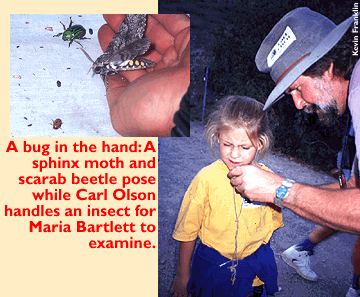
BUGS AND FINE dining go quite well together, or at least so goes the thinking of the 40 people embarking on this trip to look at nighttime insects.
"An evening of blacklighting and outdoor dining featuring the nocturnal insects of Southern Arizona," reads the notice. At first glance it appears that assorted bugs are slated for the dinner platter, a daring would-be offer by Piet Van de Mark of Baja Frontier Tours, though not likely a profitable one. Further reading reveals that more conventional food will adorn the plates saving the bugs for viewing only.
On the drive down, it becomes clear that most of the folks on the trip are not hard-core entomologists on a social outing to let their antennae down. The majority are run-of-the-mill people looking to better understand of our fellow Earthlings, from their multiple legs on up.
"I would like to change my attitude toward insects," says Debbie Hoscheidt, who recently challenged her arachnophobia head-on by holding a wild tarantula.
Van de Mark himself is working on a case of insect fear and loathing, so University of Arizona Associate Curator of Entomology Carl Olson and his assistant Gene Hall are coming along on the trip to handle the buggy side of business while Van de Mark and his team handle the food.
We drive to Box Canyon in the foothills of the Santa Rita Mountains 30 miles south of Tucson. Pine-oak woodland surrounds us and this particular location makes for excellent insect viewing, says Mary Erickson, Arizona-Sonora Desert Museum special events coordinator. Erickson, a botanist and all-around natural historian, came along to help her friend Van de Mark. The Santa Ritas, Erickson says, cap the intersection of the maximum range for many Mexican and Rocky Mountain insects, as well as species from the west and east. For this reason, an especially high level of insect diversity can be found here.
Once in the canyon, Olson introduces us to the critical role of insects, even parasites.
 "If you have a lot of bugs eating your plants," Olson
says, "it's your fault, not the bugs'. You've got to figure
out what it is you're doing wrong."
"If you have a lot of bugs eating your plants," Olson
says, "it's your fault, not the bugs'. You've got to figure
out what it is you're doing wrong."
Talking about a praying mantis egg case with signs of some parasitism, Olson says "Parasites aren't as bad as we make them out to be. They will never devour an entire mantis nest. If they did that there would be nothing left for the next generation. That's a dead end. They'd be like people and all the stupid things we do."
With a newfound appreciation for our leggy neighbors we head off to devour a wonderful dinner of our own. Van de Mark has created a top-flight restaurant in the wilderness beneath a roof of fabulously bright stars. A fine meal of rotisserie chicken, tabouli, fresh fruit and cheesecake greets us at our temporary tables. Afterward we head off to see what manner of creatures Olson has lured in with his blacklights now that darkness has fallen.
For reasons not entirely understood by entomologists, ultraviolet light lures in many different kinds of insects. In two different locations, Olson and Hall have propped up a white bed sheet with a blacklight in its center. The light casts a purplish glow on the sheet and the people standing nearby.
At first sight it seems like some hellish vision from a Stephen King novel has come to life as the group approaches the sheet literally teeming with thousands of different insects. The mighty legs of the graybird grasshopper kick it onto one man's shoulder while underwing moths, plain and bark-like while at rest, reveal bright bursts of color designed to confuse predators as they flitter about.
For sheer ingenuity the bombardier beetle takes the prize. Olson captures one and demonstrates that the beetle, when threatened, will mix two chemicals contained in its body and launch them out its derriere. The conflagration creates a boiling, noxious and corrosive cloud the marble-sized insect can fire in virtually any direction, preferably in the face of a would-be predator.
The headliner for the evening was supposed to be the beautiful scarab beetles with their emerald green carapaces shining like finely polished jewels. Several beetles showed up and wowed everyone, but they were quickly upstaged by a giant polyphemus silk moth. This moth was just shy of a dinner plate in diameter. With swirls and four spots on its dove-size wings, the moth stole the show with its butterfly-like beauty.
"This is almost as rare as coming across a gila monster in the wild," says Olson. In 20 years he has seen three or four polyphemus moths. He quickly points out, however, that he doesn't go out looking for them and often retires before their typical midnight or 1 a.m. appearances. For all anyone knows, there could be hundreds in this canyon alone, Olson says.
One or a million, this queen of the night solidifies in most everyone's minds the stunning nature of Arizona's bugs, even the less-glorious ones.
"I learned they're not gross once you get used to them," says the 10-year-old Dmitri Bartlett.
Interested in seeing Olson and Van de Mark in action? Both will be operating a blacklight as part of the Arizona-Sonora Desert Museum's Summer Evenings program Saturday, September 2, on the gift shop patio. Call the museum at 883-2702 for information. Van de Mark's next natural history tour will be an evening of telescope viewing and fine dining as the Perseid Meteor Showers rain overhead Saturday, August 12. Call 887-2340 for information.








